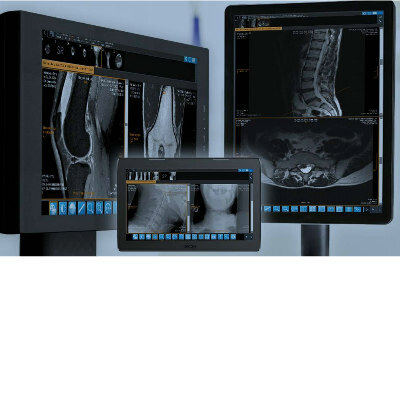U.S. Plans Production of Medical Isotopes in 2018
|
By MedImaging International staff writers Posted on 26 Apr 2017 |

Image: The University of Missouri Research Reactor (Photo courtesy of MURR).
Once operational, the University of Missouri Research Reactor will be capable of supporting nearly half of U.S. demand for molybdenum-99 (Mo-99), which currently must be imported from outside North America.
MURR and its partners Nordion and General Atomics have announced that MURR’s license amendment request (LAR) has been submitted to the U.S. Nuclear Regulatory Commission, a critical step towards implementing domestic U.S. production of Mo-99. Once approved, MURR will begin producing Mo-99 using selective gaseous extraction (SGE), a proprietary technology developed by GA to extract the isotope from low enriched uranium targets.
The patented approach will produce Mo-99 of high specific activity, while avoiding the production of liquid uranium waste, a significant problem with existing technologies that require highly enriched uranium (HEU). The extracted Mo-99 will be sent to Nordion for final purification and distribution to radiopharmaceutical manufacturers, after which it will be distributed to hospitals and medical facilities around the world. Nordion will continue to maintain its conventional Mo-99 processing capacity through March 31, 2018, in the event of a significant global shortage of Mo-99.
“This LAR submission shows the Nuclear Regulatory Commission that we will have all of the technology, expertise, and safety measures needed to begin producing Mo-99 in place and ready to go once approval has been received,” said Ralph Butler, executive director of MURR. “As a public research institution, we are proud to play a partnership role with GA and Nordion in helping America secure a new, domestic source of Mo-99.”
The most important medical isotope, technetium-99m (Tc-99m), is obtained from the decay of its parent Mo-99, and is used in more than 80% of all nuclear medicine procedures. Mo-99 is packed into source containment vessels and distributed to hospitals, where nuclear medicine specialists can draw off the Tc-99m as needed for about a week. Because of its unstable nature, Mo-99 does not occur naturally and is traditionally produced using HEU in research reactors in Canada, the Netherlands, Belgium, France, Australia, and South Africa.
MURR and its partners Nordion and General Atomics have announced that MURR’s license amendment request (LAR) has been submitted to the U.S. Nuclear Regulatory Commission, a critical step towards implementing domestic U.S. production of Mo-99. Once approved, MURR will begin producing Mo-99 using selective gaseous extraction (SGE), a proprietary technology developed by GA to extract the isotope from low enriched uranium targets.
The patented approach will produce Mo-99 of high specific activity, while avoiding the production of liquid uranium waste, a significant problem with existing technologies that require highly enriched uranium (HEU). The extracted Mo-99 will be sent to Nordion for final purification and distribution to radiopharmaceutical manufacturers, after which it will be distributed to hospitals and medical facilities around the world. Nordion will continue to maintain its conventional Mo-99 processing capacity through March 31, 2018, in the event of a significant global shortage of Mo-99.
“This LAR submission shows the Nuclear Regulatory Commission that we will have all of the technology, expertise, and safety measures needed to begin producing Mo-99 in place and ready to go once approval has been received,” said Ralph Butler, executive director of MURR. “As a public research institution, we are proud to play a partnership role with GA and Nordion in helping America secure a new, domestic source of Mo-99.”
The most important medical isotope, technetium-99m (Tc-99m), is obtained from the decay of its parent Mo-99, and is used in more than 80% of all nuclear medicine procedures. Mo-99 is packed into source containment vessels and distributed to hospitals, where nuclear medicine specialists can draw off the Tc-99m as needed for about a week. Because of its unstable nature, Mo-99 does not occur naturally and is traditionally produced using HEU in research reactors in Canada, the Netherlands, Belgium, France, Australia, and South Africa.
Latest Nuclear Medicine News
- New SPECT/CT Technique Could Change Imaging Practices and Increase Patient Access
- New Radiotheranostic System Detects and Treats Ovarian Cancer Noninvasively
- AI System Automatically and Reliably Detects Cardiac Amyloidosis Using Scintigraphy Imaging
- Early 30-Minute Dynamic FDG-PET Acquisition Could Halve Lung Scan Times
- New Method for Triggering and Imaging Seizures to Help Guide Epilepsy Surgery
- Radioguided Surgery Accurately Detects and Removes Metastatic Lymph Nodes in Prostate Cancer Patients
- New PET Tracer Detects Inflammatory Arthritis Before Symptoms Appear
- Novel PET Tracer Enhances Lesion Detection in Medullary Thyroid Cancer
- Targeted Therapy Delivers Radiation Directly To Cells in Hard-To-Treat Cancers
- New PET Tracer Noninvasively Identifies Cancer Gene Mutation for More Precise Diagnosis
- Algorithm Predicts Prostate Cancer Recurrence in Patients Treated by Radiation Therapy
- Novel PET Imaging Tracer Noninvasively Identifies Cancer Gene Mutation for More Precise Diagnosis
- Ultrafast Laser Technology to Improve Cancer Treatment
- Low-Dose Radiation Therapy Demonstrates Potential for Treatment of Heart Failure
- New PET Radiotracer Aids Early, Noninvasive Detection of Inflammatory Bowel Disease
- Combining Amino Acid PET and MRI Imaging to Help Treat Aggressive Brain Tumors
Channels
Radiography
view channel
Novel Breast Imaging System Proves As Effective As Mammography
Breast cancer remains the most frequently diagnosed cancer among women. It is projected that one in eight women will be diagnosed with breast cancer during her lifetime, and one in 42 women who turn 50... Read more
AI Assistance Improves Breast-Cancer Screening by Reducing False Positives
Radiologists typically detect one case of cancer for every 200 mammograms reviewed. However, these evaluations often result in false positives, leading to unnecessary patient recalls for additional testing,... Read moreMRI
view channel
PET/MRI Improves Diagnostic Accuracy for Prostate Cancer Patients
The Prostate Imaging Reporting and Data System (PI-RADS) is a five-point scale to assess potential prostate cancer in MR images. PI-RADS category 3 which offers an unclear suggestion of clinically significant... Read more
Next Generation MR-Guided Focused Ultrasound Ushers In Future of Incisionless Neurosurgery
Essential tremor, often called familial, idiopathic, or benign tremor, leads to uncontrollable shaking that significantly affects a person’s life. When traditional medications do not alleviate symptoms,... Read more
Two-Part MRI Scan Detects Prostate Cancer More Quickly without Compromising Diagnostic Quality
Prostate cancer ranks as the most prevalent cancer among men. Over the last decade, the introduction of MRI scans has significantly transformed the diagnosis process, marking the most substantial advancement... Read moreUltrasound
view channel
Deep Learning Advances Super-Resolution Ultrasound Imaging
Ultrasound localization microscopy (ULM) is an advanced imaging technique that offers high-resolution visualization of microvascular structures. It employs microbubbles, FDA-approved contrast agents, injected... Read more
Novel Ultrasound-Launched Targeted Nanoparticle Eliminates Biofilm and Bacterial Infection
Biofilms, formed by bacteria aggregating into dense communities for protection against harsh environmental conditions, are a significant contributor to various infectious diseases. Biofilms frequently... Read moreGeneral/Advanced Imaging
view channel
New AI Method Captures Uncertainty in Medical Images
In the field of biomedicine, segmentation is the process of annotating pixels from an important structure in medical images, such as organs or cells. Artificial Intelligence (AI) models are utilized to... Read more.jpg)
CT Coronary Angiography Reduces Need for Invasive Tests to Diagnose Coronary Artery Disease
Coronary artery disease (CAD), one of the leading causes of death worldwide, involves the narrowing of coronary arteries due to atherosclerosis, resulting in insufficient blood flow to the heart muscle.... Read more
Novel Blood Test Could Reduce Need for PET Imaging of Patients with Alzheimer’s
Alzheimer's disease (AD), a condition marked by cognitive decline and the presence of beta-amyloid (Aβ) plaques and neurofibrillary tangles in the brain, poses diagnostic challenges. Amyloid positron emission... Read more.jpg)
CT-Based Deep Learning Algorithm Accurately Differentiates Benign From Malignant Vertebral Fractures
The rise in the aging population is expected to result in a corresponding increase in the prevalence of vertebral fractures which can cause back pain or neurologic compromise, leading to impaired function... Read moreImaging IT
view channel
New Google Cloud Medical Imaging Suite Makes Imaging Healthcare Data More Accessible
Medical imaging is a critical tool used to diagnose patients, and there are billions of medical images scanned globally each year. Imaging data accounts for about 90% of all healthcare data1 and, until... Read more
Global AI in Medical Diagnostics Market to Be Driven by Demand for Image Recognition in Radiology
The global artificial intelligence (AI) in medical diagnostics market is expanding with early disease detection being one of its key applications and image recognition becoming a compelling consumer proposition... Read moreIndustry News
view channel
Bayer and Google Partner on New AI Product for Radiologists
Medical imaging data comprises around 90% of all healthcare data, and it is a highly complex and rich clinical data modality and serves as a vital tool for diagnosing patients. Each year, billions of medical... Read more




















